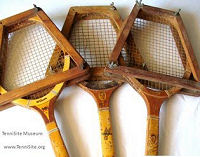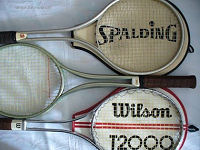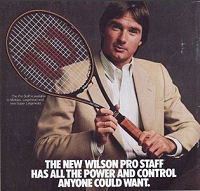
Evolution of Tennis Rackets
This article is intended as a brief, nostalgic journey through tennis racket development, mentioning significant milestones.
It is NOT intended as a complete history of tennis rackets…there are any number of internet sites that have that type of article and go into detail to the nth degree.
It is based mainly on our (tennisnuts.com) experience in the tennis world.
How have we got to the latest rackets from the wooden rackets of the 70's?
WOODEN RACKETS: 
The 70's were dominated by wooden rackets produced by Dunlop , Slazenger , Wilson and Spalding.
The 2 classic wooden rackets of all time were the Dunlop Maxply Fort and the Wilson Jack Kramer.
The rackets were generally heavy with extremely small sweet spots. The rackets were generally quite flexible .
This made it a very level playing field for everyone, with the only variations possible being in the type of string and tensions.
The strings were generally natural gut (expensive and not very consistent/durable or cheap.
STEEL RACKETS: 
Jimmy Connors used a Wilson T2000 all steel racket to devastating effect in a Wimbledon final against Ken Rosewall (using a wooden racket).
This suddenly brought racket technology into the forefront and a number of developments started taking place. The steel construction enabled consistency of playing characteristics.
Interestingly, at the same time, Bjorn Borg was developing with Donnay a racket that was wood based but reinforced with modern materials to provide extra stiffness. He used to string his racket at 70 lbs plus! In contrast John McEnroe would string his at 45 lbs !
GRAPHITE RACKETS: 
Graphite rackets started appearing after this with Arthur Ashe one of the first to use a 100% graphite racket (Head Prestige).
A number of pros started using these or the Wilson prostaff 6.0 (used by Sampras albeit with a larger head!).
Graphite enabled stiffness, but the weight was still quite heavy, with not much vibration dampening.
Dunlop then brought out the Dunlop 200g, which was the first of the lighter, more powerful rackets. John McEnroe was the first pro to use one of these. This racket graphite injected with foam to make it lighter and more vibration dampening.
ULTRA LIGHT/BIG HEADS
Prince brought out the Prince Pro which was basically a lightweight, oversize racket which was also quite flexible (aluminium construction).
This allowed a good mixture of power and control. This was the first step into forgiving rackets for the average player.
As graphite technology improved , bigger and lighter rackets were possible using graphite.
OTHER SIGNIFICANT MILESTONES,
The Wilson Profile and the Head Genesis were the first significant thick framed, lightweight, powerful graphite rackets.
Wilson introduced Hammer (Head Heavy) technology.
Fischer used their expertise from Ski construction to produce a variety of 'players frames'.
Prince introduced the longbody concept.
Generally, there was a proliferation of different rackets and technologies, with at least a couple of disasters. Remember the Fishback double sided stringing pattern ? It was a bit of a trampoline!
TITANIUM /HYPERCARBON TECHNOLOGY:
The introduction by Head of titanium technology through the TiS6 was a significant milestone in racket technology in 1998.
It enabled rackets to be ultralight, powerful AND vibration dampening.
Wilson's Hypercarbon is very similar to this.
DEVELOPING TECHNOLOGY:
Over the past few years, two distinct strands have developed the pro's have generally carried on using fairly heavy, thin beamed rackets which have a small sweet spot and are not very powerful !
The average club player has had a number of technologies aimed at making the game easier and more comfortable.
Some people, especially very good players and some coaches get quite sniffy about these lightweight, easy to manoeuvre and comfortable rackets.
Our opinion is that there is now something to suit every budget, playing style and ability.
Why use a heavy, thin beamed, small head racket when your standard does not warrant it?
If you are a middle aged man or woman of average standard do you really want to use Pete Sampras' racket? He has arms like tree trunks!
CURRENT TRENDS:
All the major manufacturers have their own name for different technologies but basically they are producing a full range of rackets from ultra lightweight, powerful rackets, to heavy thin beamed control rackets, with everything in between as well.
POWER RACKETS They are now available in a variety of head shapes and sizes and materials Titanium, Hypercarbon, Triple threat, Air Carbon titanium Mesh etc. They are available in a range of different weights and levels of vibration dampening.
Basically these are lightweight powerful rackets with big sweetspots.
ULTIMATE CONTROL RACKETS These are now available with a choice of weights , balance points and stiffnesses, but basically these are thin beamed with small heads and suit the better players.
MID POWER / MID CONTROL RACKETS In between these 2 extremes there are loads of rackets which provide a nice mixture of power and control.
All brands have comprehensive ranges at a number of price levels.
Find all this bewildering?
Click here to go our knowledge article on 'How to choose a tennis racket' at www.tennisnuts.com












